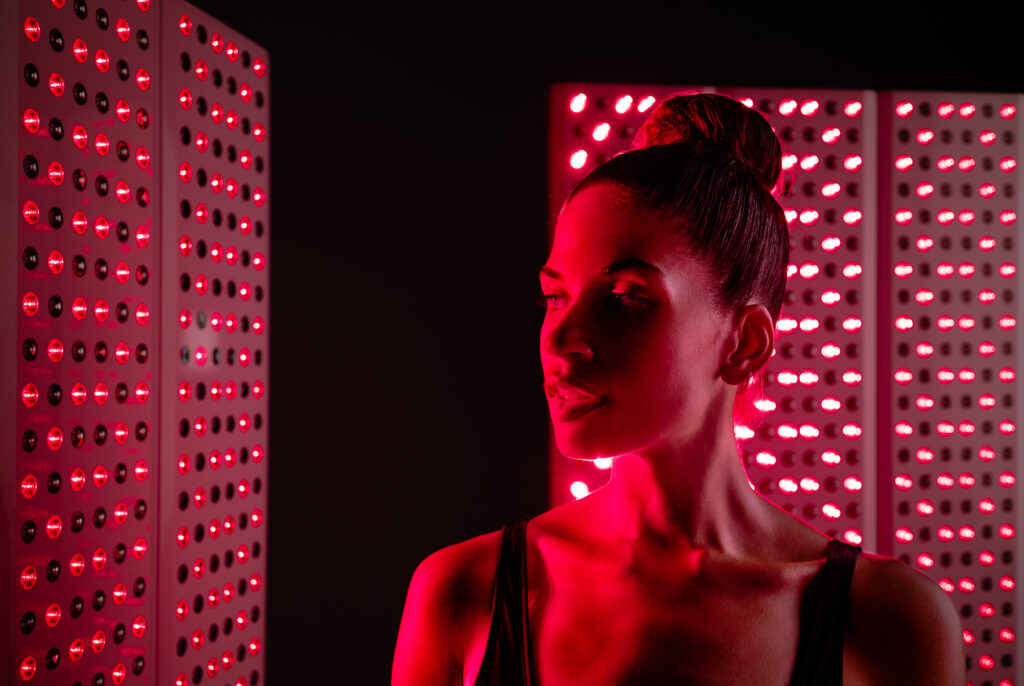Unlocking the Power of Red Light Therapy: A Comprehensive Guide to Wellness and Inflammation Reduction

In recent years, red light therapy has emerged as a promising tool in the wellness world, lauded for its ability to enhance health and lower inflammation. Whether you’re an athlete seeking faster recovery, someone struggling with chronic pain, or simply interested in optimizing your overall well-being, red light therapy offers a range of benefits that can support your journey. Let’s dive into the science behind red light therapy and explore how it can contribute to a healthier, more vibrant life.
What is Red Light Therapy?
Red light therapy, also known as photobiomodulation, is a non-invasive treatment that uses specific wavelengths of red and near-infrared light to penetrate the skin and tissues. These wavelengths stimulate cellular activity, promoting healing, reducing inflammation, and enhancing various aspects of health. The therapy is typically delivered through LED panels, handheld devices, or full-body beds, making it accessible for at-home use or in professional wellness settings.
The Systemic Effects of Red Light Therapy
One of the most compelling aspects of red light therapy is its ability to produce systemic effects. When red light penetrates the skin, it reaches the mitochondria—the powerhouse of the cell—boosting energy production (ATP) and enhancing cellular function. This process has a ripple effect throughout the body, leading to improved cellular health and vitality across multiple systems.
ARTICLE CONTINUES BELOW
Schedule a Consultation TODAY!
We would love to sit down with you and chat about your experiences and current pain points.
Pain Relief and Inflammation Reduction
Red light therapy is particularly well-regarded for its ability to reduce pain and inflammation, making it a go-to treatment for individuals with chronic pain conditions, such as arthritis, fibromyalgia, and muscle injuries. The anti-inflammatory effects are largely due to the therapy’s ability to modulate the production of pro-inflammatory cytokines and increase circulation, allowing for more efficient delivery of oxygen and nutrients to tissues.
In clinical studies, red light therapy has been shown to decrease pain levels and improve joint function, offering a non-pharmaceutical option for pain management. This makes it a valuable tool for those looking to reduce their reliance on pain medications and explore more natural approaches to health.
Skin Health and Anti-Aging Benefits
Beyond pain relief, red light therapy has gained popularity for its skin-rejuvenating properties. The therapy stimulates collagen production, which helps to reduce the appearance of fine lines, wrinkles, and scars. It also promotes faster wound healing and can improve conditions like acne, rosacea, and psoriasis.
The anti-aging benefits of red light therapy make it a popular choice in the beauty industry, where it’s used to enhance skin tone, texture, and overall appearance. Regular sessions can leave your skin looking more youthful, radiant, and resilient to the effects of aging.
Performance Recovery and Muscle Healing
For athletes and fitness enthusiasts, red light therapy offers a powerful tool for performance recovery and muscle healing. The therapy’s ability to reduce inflammation and increase circulation accelerates the recovery process after intense workouts or injuries. By enhancing blood flow to muscles, red light therapy helps to clear out metabolic waste products, reduce muscle soreness, and promote faster repair of damaged tissues.
Athletes who incorporate red light therapy into their recovery routines often experience reduced downtime between workouts and improved overall performance. Whether you’re training for a marathon or simply aiming to stay active, red light therapy can support your fitness goals by keeping your body in peak condition.
Sleep Optimization and Circadian Rhythm Support
In our modern world, disrupted sleep patterns and circadian rhythms are common issues, often leading to fatigue, poor cognitive function, and a host of health problems. Red light therapy offers a natural way to support healthy sleep and circadian rhythms by influencing the body’s production of melatonin—the hormone responsible for regulating sleep-wake cycles.
Exposure to red light in the evening can help signal to your body that it’s time to wind down, promoting a more restful night’s sleep. In the morning, red light exposure can support wakefulness and energy levels, helping to reset your internal clock and align your circadian rhythm with the natural light-dark cycle.
Enhanced Blood Flow and Cardiovascular Health
Healthy blood flow is essential for overall well-being, as it ensures that oxygen and nutrients are efficiently delivered to all parts of the body. Red light therapy has been shown to enhance circulation by stimulating the production of nitric oxide—a molecule that dilates blood vessels and improves blood flow.
This improved circulation can have a positive impact on cardiovascular health, reducing the risk of conditions like hypertension and atherosclerosis. For those looking to support heart health and maintain optimal blood pressure, red light therapy offers a safe and effective solution.
Mental Acuity and Cognitive Function
The benefits of red light therapy extend beyond physical health to include mental acuity and cognitive function. Research suggests that red light therapy can enhance brain function by improving mitochondrial activity in neurons, leading to increased energy production and better overall brain health.
This cognitive boost can manifest as improved focus, memory, and mental clarity—benefits that are especially valuable in our fast-paced, information-rich world. Whether you’re looking to enhance productivity at work or simply stay sharp as you age, red light therapy can support your cognitive well-being.
Supporting Overall Well-Being and Mood
Red light therapy also has a positive impact on mood and overall well-being. The therapy’s ability to reduce inflammation, enhance circulation, and improve sleep all contribute to a greater sense of balance and vitality. Additionally, red light exposure has been linked to increased serotonin levels—a neurotransmitter associated with feelings of happiness and well-being.
For those dealing with mood disorders, such as depression or anxiety, red light therapy may offer a complementary approach to traditional treatments. By promoting relaxation, reducing stress, and supporting a positive mood, red light therapy can help you feel more centered and resilient in the face of life’s challenges.
How to Incorporate Red Light Therapy into Your Wellness Routine
Given the wide range of benefits, it’s no wonder that red light therapy is becoming a staple in wellness routines around the world. Whether you’re new to the therapy or looking to deepen your practice, here are some tips for incorporating red light therapy into your daily life:
- Start with Short Sessions: If you’re new to red light therapy, begin with short sessions (5-10 minutes) and gradually increase the duration as your body adapts.
- Target Specific Areas: Depending on your goals, you may choose to target specific areas of your body, such as the face for skin health, the joints for pain relief, or the back for muscle recovery.
- Consistency is Key: For best results, incorporate red light therapy into your routine on a regular basis. Daily or several times a week sessions are ideal for maintaining the benefits.
- Pair with Other Wellness Practices: Enhance the effects of red light therapy by pairing it with other wellness practices, such as chiropractic care, guided stretch sessions, or a personalized nutrition plan. Chiropractic care can help align your body and improve nervous system function, further reducing pain and enhancing overall well-being. Guided stretch sessions can improve flexibility and muscle recovery, complementing the healing effects of red light therapy. A personalized nutrition plan ensures that your body is fueled with the right nutrients, supporting cellular health and boosting the benefits of your wellness routine. This holistic approach can amplify the benefits and promote overall well-being.
- Monitor Your Progress: Keep track of how you feel before and after red light therapy sessions. Note any changes in pain levels, skin appearance, sleep quality, and mood to gauge the therapy’s impact on your health.
Conclusion
Red light therapy is a versatile and effective wellness tool that offers a multitude of benefits for both physical and mental health. By reducing inflammation, enhancing circulation, promoting skin health, and supporting cognitive function, red light therapy can help you achieve a higher level of wellness and vitality. Whether you’re looking to relieve pain, improve sleep, or simply boost your overall well-being, red light therapy is a powerful ally on your journey to optimal health.
Incorporate this therapy into your wellness routine and experience the transformative effects for yourself—your body and mind will thank you.
Back On Track 2 Wellness is offering a special on buy 2 red light sessions and get 1 free. So take care of you today and contact our office to get your red light session scheduled.
Schedule Your Telehealth Consultation
We would love to sit down with you and chat about your experiences and current health complaints.
The information on this website has not been evaluated by the Food & Drug Administration or any other medical body. We do not aim to diagnose, treat, cure or prevent any illness or disease. Information is shared for educational purposes only. You must consult your doctor before acting on any content on this website, especially if you are pregnant, nursing, taking medication, or have a medical condition.

By Dr. Todd W. Bunning
Dr. Todd W. Bunning’s Chiropractic and Functional Medicine services reach far beyond the local Roseville area, with webcam consultations available for patients in any location. With over 21+ years of Private Practice experience, Dr. Todd continues to focus on the individual: science-based methods to address whole-body health factors.
Dr. Todd’s education didn’t stop when he graduated from Life West Chiropractic College in 2003. Today, he’s continuing to receive training and is chipping away on numerous post-graduate degree programs. This unique blend of clinical health investigation and Lifestyle Medicine application helps people of all ages find the underlying factors that result in chronic disease.